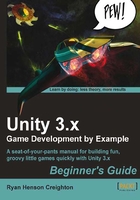
Pong
Seriously, Pong? Yes, Pong. The British Academy of Film and Television Arts hosts an online version of the classic game (http://www.bafta.org/awards/video-games/play-pong-online,678,BA.html). The original Pong is credited with kickstarting the commercial video game industry that we know today.
The mechanic : Pong takes its name from ping pong—a real-world activity where two players use paddles to bounce a ball at each other across a table with a tiny net. Ping pong was adapted from tennis, after people finally realized that all that running around was too much effort.
Some real-world activities lend themselves very well to video game mechanics. Not quite 50 years old, the video game industry is still very much in its infancy. There is an enormous wealth of fun stuff in the physical world (like playing ping pong or blowing up tanks) that's waiting to be adapted to a terrific video game mechanic. Are you clever enough to find one of those undiscovered mechanics and build the next Pong?
The skin : Like many early games, Pong obviously leaves a lot to be desired. Video game skins of tennis and ping pong have come a very long way, and can be radically diverse. Compare the ultra-realistic treatment of ping pong in Rockstar Games presents Table Tennis with the all-out insanity of Nintendo's Mario Tennis games, which add spinning stars and carnivorous plants to the playing field.


In both cases, be aware of the HUD elements. All three games—Pong, Table Tennis, and Mario Power Tennis—display a dynamic (changeable) piece of text on the screen to show score data. Table Tennis also has player names, an exertion meter, and little circles that display how many games each player has won. Look at the positioning of those elements. In all cases, and in our Motherload example, these HUD elements are displayed at the top of the screen.
The feature set: As Pong evolved, the feature set became far richer. Satisfied that the simple mechanic of hitting a virtual ball back and forth was enough to hang a game on, both Rockstar Games and Nintendo were able to blow out Pong with feature sets so juicy that the games' Pong origins were barely recognizable. By implementing tennis-style scoring, they made these games much more like tennis with very little effort. Both games add tournaments, rankings, and different player characters with varying skill sets. Mario Power Tennis adds about 30 new features involving mushrooms. Pong is a true testament to the level of complexity a simple, strong game mechanic can aspire to. But, again, if you want to make a fully-featured game like Table Tennis or Mario Power Tennis, the key is to start with a simple game like Pong.